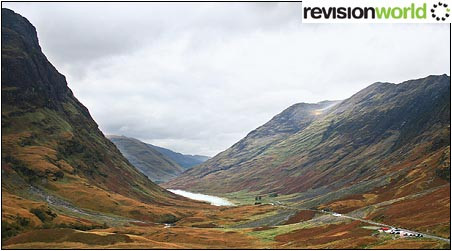Glacial Troughs & Associated Landforms
In mountain environments, valley glaciers severely modify former river valleys to produce very deep, steep-sided, flat-floored U-shaped valleys or glacial troughs.

Variations in rock resistance or locations where glaciers merge give rise to over-deepening of the valley floor and the formation of long, narrow ribbon lakes.
Where over-deepening occurs along the coasts, deep sea fjords may form as sea-levels rise and flood the former glaciated valley.
Along the sides of the glacial troughs are truncated spurs, rocky outcrops which form the ends of former interlocking spurs that have been eroded by the valley glacier.
Tributary river valleys contain only small valley glaciers and due to the small amount of erosive power that they have, these valleys remain at a higher level and form hanging valleys, often with dramatic waterfalls where tributary streams rejoin the main valley.
In the glacial troughs post-glaciation, small misfit streams occupy the now enlarged valleys.
